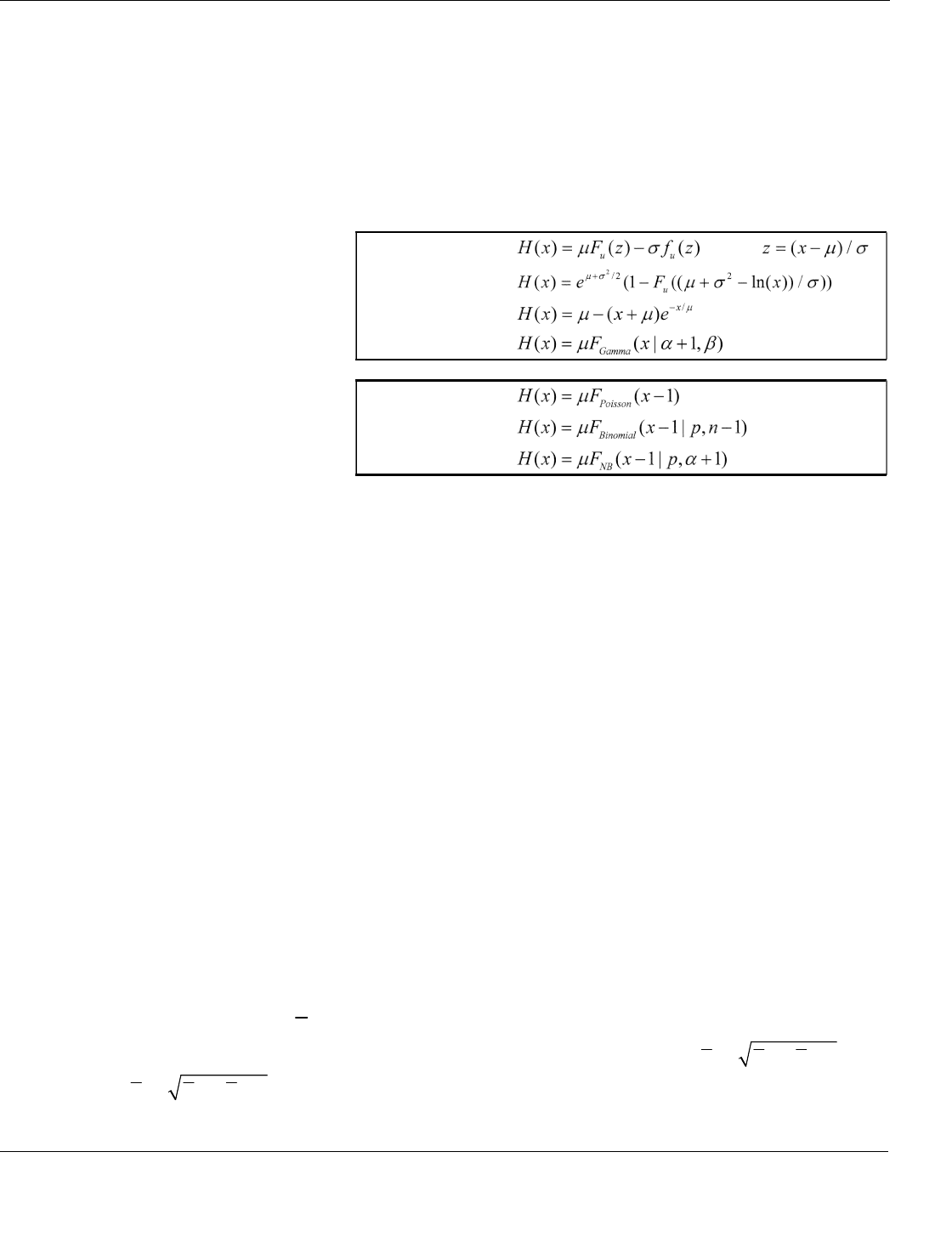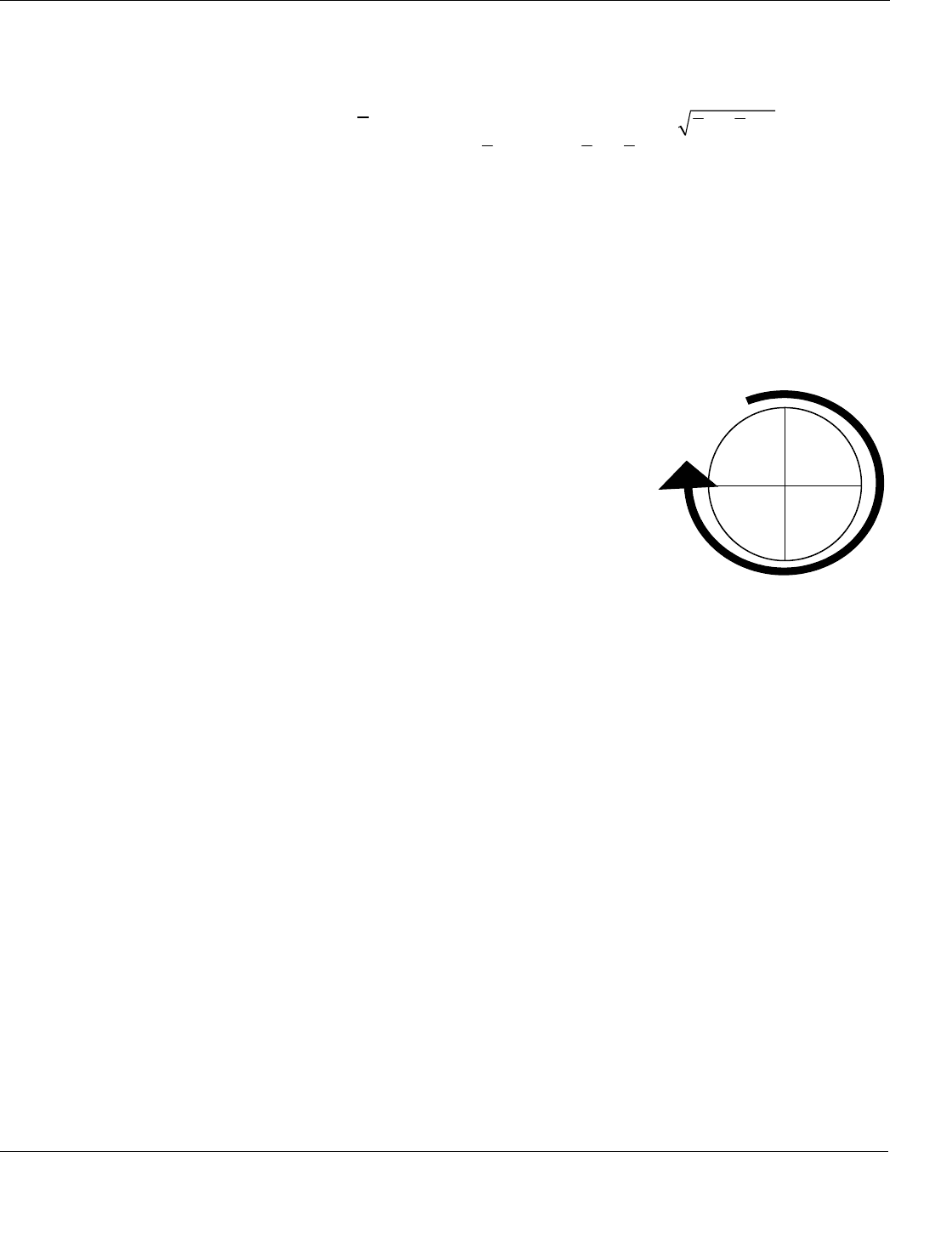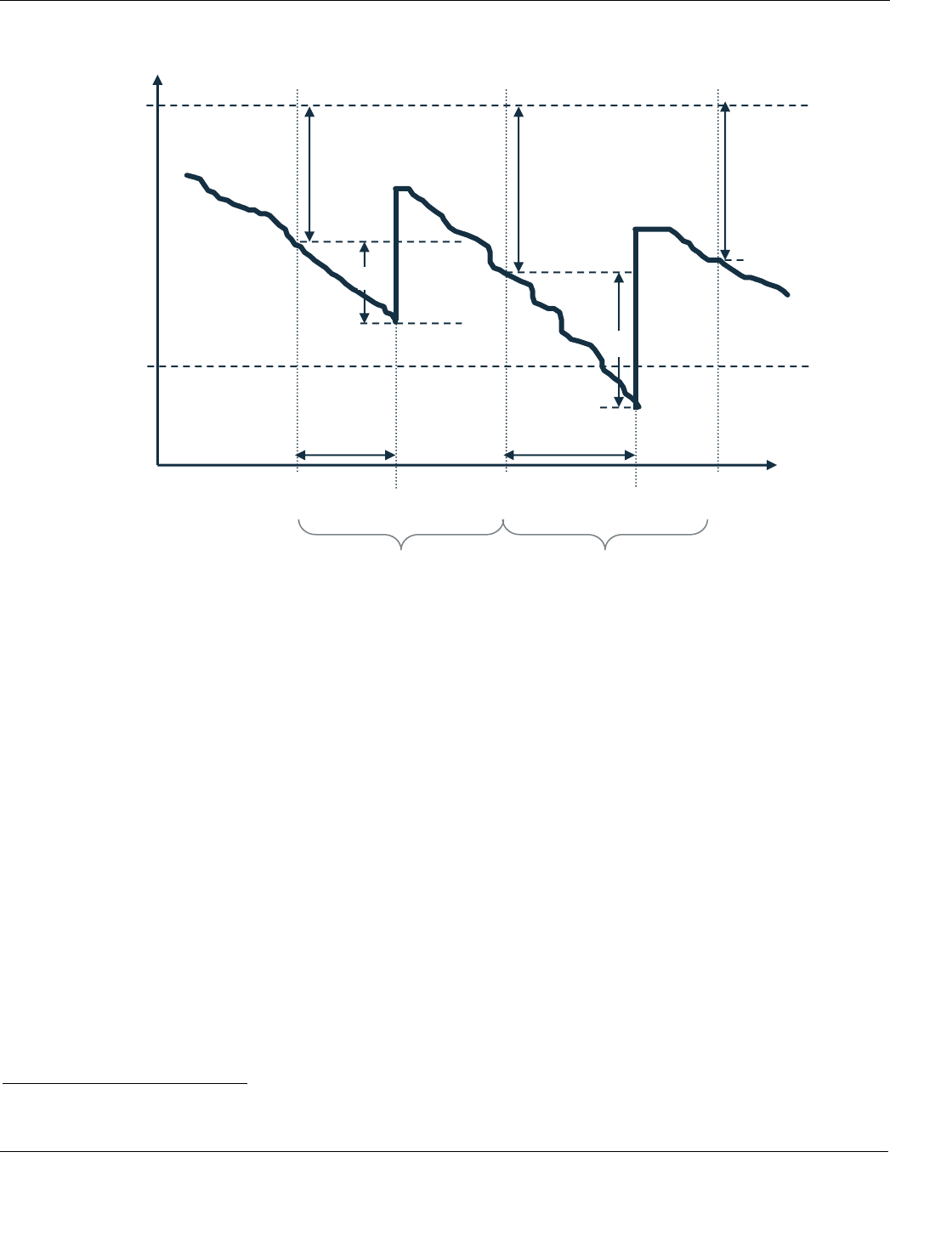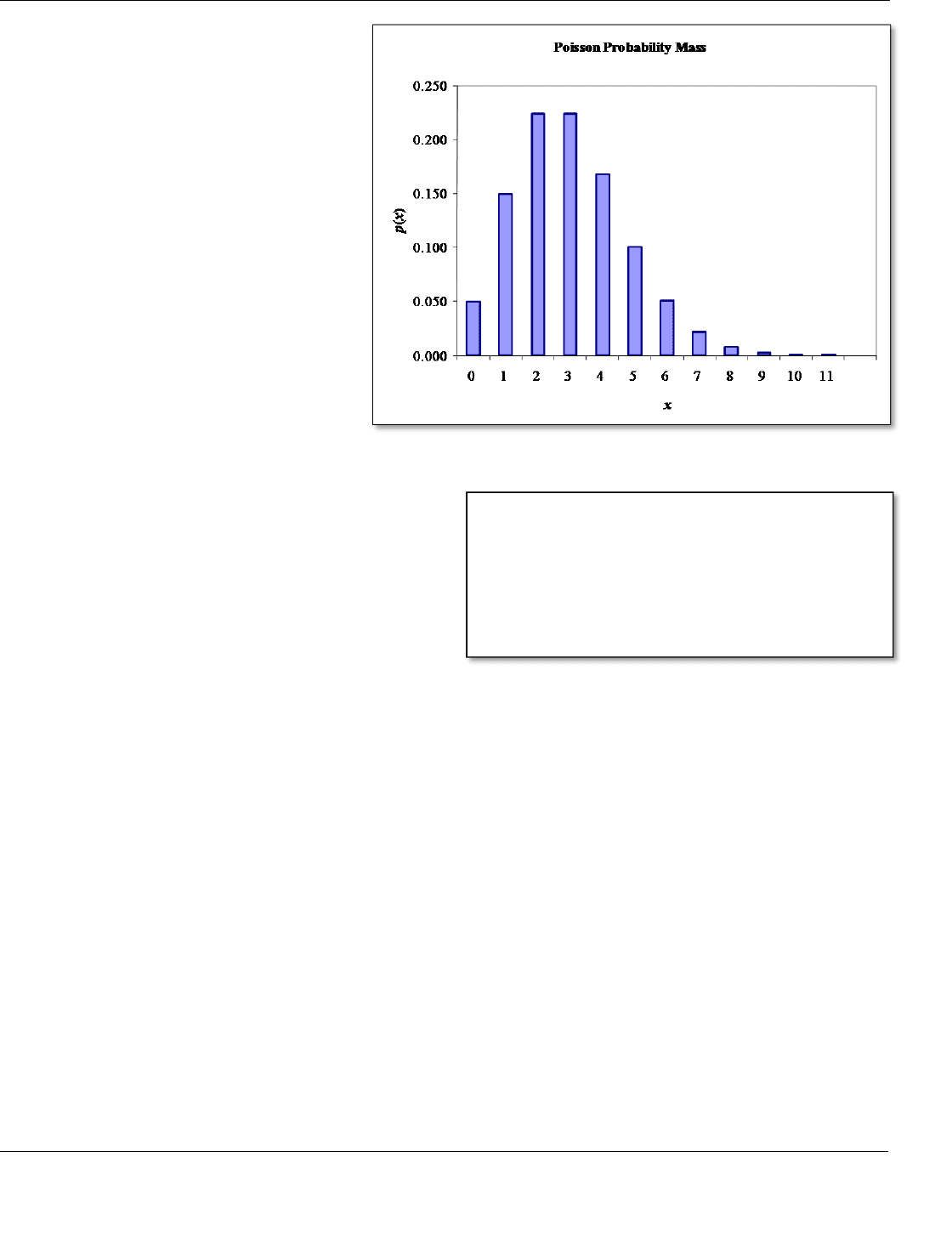Hill A.V. The Encyclopedia of Operations Management: A Field Manual and Glossary of Operations Management Terms and Concepts
Подождите немного. Документ загружается.


ptg6843605
partial moment – p-chart
The Encyclopedia of Operations Management Page 256
value ( )
x
X
x
f x dx
. The partial expectation evaluated at x
0
is
0
0
0
( ( ) ( ) .)
x
X
x x x
H x xf x dx xf x dx
Blumenfeld (2010) and others defined the partial expectation as the weighted tail of the distribution
0
0 0
'( ) ( ) ( )
X
x x
H x xf x dx H x
. The partial expectation is related to the conditional expectation with
0 0 0
( ) ( | ) ( )H x E X X x P X x
or
0 0 0
( ) ( | )(1 ( ))H x E X X x F x
.
The partial expectation functions
for several distributions are presented in
the table on the right. These equations
were derived by the author from the tail
conditional expectation functions in
Landsman and Valdez (2005). Winkler,
Roodman, and Britney (1972) presented
closed-form expressions for the partial
expectations for several distributions.
See gamma distribution, mean,
probability density function, safety
stock.
partial moment – See partial
expectation.
Parts per Million (PPM) – See Defective Parts per Million (DPPM).
pay for performance – See gainsharing.
pay for skill – A compensation policy that rewards employees for developing new capabilities; also called skill-
based pay, pay for knowledge, and pay for learning.
The organization provides training on a set of skills and increases the hourly pay rate for workers who can
demonstrate that they have acquired new skills. For example, an employee who learns to use a laser welder
might be paid an extra $0.25 per hour.
Some of the benefits of a pay for skill program include (1) allowing employers to cover for an absent worker,
(2) reducing inventory and cycle time when workers can move to where the work is, (3) reducing boredom and
increasing employee engagement, and (4) giving workers a broader perspective of the process, which gives them
insights that can be used to improve the process.
On the negative side, pay for skill will not achieve greater performance for the employee if the skill is not
needed or not used. Job rotation can also achieve many of the same benefits. A one-time bonus might make
more sense in some cases. A similar approach is to create a labor grade (pay grade) system in which employees
get promoted to new pay grades after mastering new skills.
See gainsharing, human resources, job design, job enlargement, job rotation, labor grade, piece work.
payback period – The time required to break even on an investment.
Payback ignores the time value of money and is regarded to be a crude and imprecise analysis. Much better
methods include Net Present Value (NPV) and Economic Value Added (EVA). However, payback is still a
commonly used approach for “quick and dirty” investment analysis.
See break-even analysis, financial performance metrics.
p-chart – A quality control chart used to monitor the proportion of units produced in a process that are defective; a
unit is considered defective if any attribute of the unit does not conform to the standard.
To set up a p-chart, estimate
p
, the long-term percent defective, from a large sample while the process is
under control. Then set the upper and lower control limits at
3 (1 ) /UCL p p p n
and
max( 3 (1 ) / ,0)LCL p p p n
.
Partial expectations for continuous distributions:
Normal
, where
Lognormal
Exponential
Gamma
Partial expectations for discrete distributions:
Poisson
Binomial
Negative binomial
Note: f
u
and F
u
are the pdf and CDF for the standard normal distribution.

ptg6843605
PDCA (Plan-Do-Check-Act) − pegging
Page 257 The Encyclopedia of Operations Management
Plan
Do
Check
Act
To use a p-chart, sample n units from the process every so many lots, units, or time periods. The sample
proportion is p = x/n, where x is the number of defective units found in the sample. Plot the sample proportion
on the p-chart and determine if the process is “under control.”
The p-chart is based on the binomial distribution, which is the sum of n independent Bernoulli distributed
binary (0-1) random variables with mean
p and standard deviation of the estimate
(1 ) /p p n
. The normal
distribution is a reasonable estimate of the binomial when 10np and (1 ) 10np p
.
Whereas the p-chart plots the proportion defective for any sample size, the np-chart plots the number of
defective units for a fixed sample size.
See attribute, Bernoulli distribution, binomial distribution, control chart, np-chart, Statistical Process
Control (SPC), Statistical Quality Control (SQC).
PDCA (Plan-Do-Check-Act) – A well-known four-step approach for process improvement; also called PDSA
(Plan-Do-Study-Act), the Deming Cycle, and the Shewhart Cycle.
The PDCA cycle is made up of four steps:
PLAN – Recognize an opportunity and plan the change. Plan to improve operations first by finding out what
things are going wrong and then generate ideas for solving these problems. Decide what actions might
reduce process variation.
DO – Test the change. Make changes designed to solve the problems on a
small or experimental scale first. This minimizes disruptions while testing
whether the changes will work.
CHECK – Review the test, analyze the results, and identify learning. Use
data to determine if the change was effective in reducing variation. Check
whether the small-scale or experimental changes are achieving the desired
result or not. Also, continuously check nominated key activities (regardless
of any experimentation going on) to provide information on the quality of
the output at all times and to identify new problems that might appear.
ACT – Take action based on what you learned in the check step. If the change was successful, implement
the change and identify opportunities to transfer the learning to other opportunities for improvement.
Implementation will likely require involvement of other persons and organizations (departments, suppliers,
or customers) affected by the change. If the change was not successful, document that plan and go through
the cycle again with a different plan.
Upon completion of a PDCA cycle, the cycle is repeated to test another idea. The repeated application of the
PDCA cycle to a process is known as continuous quality improvement.
The PDCA cycle was developed by Shewhart (1939). Shewhart said the cycle draws its structure from the
notion that constant evaluation of management practices, as well as the willingness of management to adopt and
disregard unsupported ideas, is the key to the evolution of a successful enterprise. W. Edwards Deming first
coined the term “Shewhart cycle” for PDCA, naming it after his mentor and teacher at Bell Laboratories in New
York. Deming promoted PDCA as a primary means of achieving continued process improvement. He also
referred to the PDCA cycle as the PDSA cycle (“S” for study) to emphasize the importance of learning in
improvement. Deming is credited with encouraging the Japanese to adopt PDCA in the 1950s.
The Japanese eagerly embraced PDCA and other quality concepts, and to honor Deming for his instruction,
they refer to the PDCA cycle as the Deming cycle. Many lean thinking programs use PDCA concepts.
Most quality improvement projects today use a similar five-step approach called DMAIC, which comes from
the lean sigma movement. Most people (including this author) find DMAIC more intuitive and easier to follow
than the PDCA or PDSA approaches.
See
DMAIC, hoshin planning, lean sigma, quality management, Total Quality Management (TQM).
PDF – See probability density function.
PDM – See product data management.
PDSA (Plan-Do-Study-Act) – See PDCA.
pegging – The process of identifying the sources of the gross requirements for an item in the MRP materials plan.

ptg6843605
percentage bill of material – performance rating
The Encyclopedia of Operations Management Page 258
Single-level pegging for a gross requirement goes up one level in the bill of material (BOM). Full-level
pegging goes all the way up to the top level. Pegging is an important tool for helping production planners
identify the impact that a late order might have on higher-level orders and customers. Pegging is like a where-
used report, but is only used for those parent items that determine the gross requirements for the item.
See bill of material (BOM), bill of material implosion, Materials Requirements Planning (MRP), where-used
report.
percentage bill of material – See bill of material (BOM).
perfect order fill rate – See fill rate.
performance management system – A set of policies and procedures with a supporting information system used
to help create and maintain alignment between the organizational and employee goals.
A good performance management system is built on four main activities:
Planning – The manager and direct reports collaboratively establish goals, objectives, outcomes, and
training requirements for the direct report.
Coaching – The manager trains, observes, and provides feedback to direct reports to improve performance.
Appraisal – The manager provides performance feedback to direct reports and documents performance for
both the pay and promotion decision processes.
Rewards – The organization provides rewards in the form of recognition, pay raises, bonuses, and
promotions.
Although performance measurement focuses only on evaluating performance, performance management
takes a broader view, with more emphasis on intentional performance development. A good performance
management system will align and coordinate individual behavior with the organization’s strategic objectives.
Culbert (2010) made 12 arguments against performance reviews:
42
Focus on finding faults and placing blame.
Focus on deviations from some ideal as weaknesses.
Focus on comparing employees.
Create competition between boss and subordinate.
Create one-sided-accountability and too many boss-dominated monologues.
Create “thunderbolts from on high,” with the boss speaking for the company.
Cause the subordinate to suffer if they make a mistake.
Create an environment that allow the big boss to go on autopilot.
Focuse on scheduled events.
Give human resource people too much power.
Do not lead to anything of substance.
Are hated, and managers and subordinates avoid doing them until they have to.
Culbert (2010) went on to propose a collaborative constant dialog between the manager and employee built
on trust and respect and where they are both responsible for success. Part of this dialog includes a “Performance
Preview” that Culbert claimed holds people accountable, gives both managers and employees helpful feedback,
and gives the company more of what it needs. He proposed three questions: (1) What are you getting from me
that you like and find helpful? (2) What are you getting from me/the company that gets in your way and that you
would like to have stopped? (3) What are you not getting from me/the company that you think would make you
more effective? Tell me how that would help you specifically to do your job better?
Coens and Jenkins (2002) make similar arguments against performance reviews and suggest that managers
should (1) provide honest feedback to employees by maintaining daily, two-way communication; (2) empower
employees to be responsible for their careers, for receiving feedback, and for holding themselves accountable for
the work to be done; (3) have the freedom to choose for themselves the most effective ways of working with
people; (4) move away from an individual performance company to an organizational improvement company;
and (5) create a culture to support the above.
See
financial performance metrics, Management by Objectives (MBO), operations performance metrics,
work measurement.
42
These are reworded slightly here.

ptg6843605
performance quality − periodic review system
Page 259 The Encyclopedia of Operations Management
performance quality – See product design quality.
performance rating – A subjective estimate of a worker’s pace of work.
A 120% performance rating means that the observer estimated that the worker was working 20% faster than
a normal worker. The performance rating is used to adjust the observed time to compute the normal time.
See normal time, standard time, time study, work measurement.
performance-based contracting – A legal relationship that allows organizations (usually governmental
organizations) to acquire services via contracts that define what is to be achieved rather than how it is to be done.
In many situations, performance-based contracting provides good value products and services. In addition,
performance-based contracting gives firms the freedom to bring new approaches to their customers.
See service guarantee, Service Level Agreement (SLA).
period cost – Expenses based on the calendar rather than the number of units produced; also called period expense.
Period costs include selling and administrative costs, depreciation, interest, rent, property taxes, insurance,
and other fixed expenses based on time. Period costs are expensed on the income statement in the period in
which they are incurred and not included in the cost of goods sold.
See overhead.
Period Order Quantity (POQ) – A simple lotsizing rule that defines the order quantity in terms of periods
supply
43
; also known as the Periodic Order Quantity, days supply, weeks supply, and months supply.
The POQ is implemented in MRP systems by setting the lotsize to the sum of the next POQ periods of net
requirements after the first positive net requirement. The optimal POQ is the Economic Order Quantity (EOQ)
divided by the average demand per period. The POQ is
2 / ( / 365)S icD
days, where D is the expected annual
demand, S is the ordering (or setup) cost, i is the carrying charge, and c is the unit cost.
See Economic Order Quantity (EOQ), lotsizing methods, periods supply, time-varying demand lotsizing
problem.
periodic review system – An order-timing rule used for planning inventories; also known as a fixed-time period
model, periodic system, fixed-order interval system, and P-model.
A periodic review system evaluates the inventory position every P time periods and considers placing an
order. Unlike a reorder point system that triggers an order when the inventory position falls below the reorder
point, a periodic review system only considers placing orders at the end of a predetermined time period, the
review period (P). The graph below shows the periodic review system through two review periods.
The periodic review system makes good economic sense when the firm has economies of scale in
transportation cost. In other words, the periodic review system should be used when the firm can save money by
shipping or receiving many different items at the same time. The optimal review period is the perod order
quantity (POQ), which is
/
D
EOQ
, where EOQ is the economic order quantity and
D
is the average demand
per period. However, in most situations, the review period is determined by other factors, such as the
transportation schedule.
The periodic review system can be implemented with either a fixed order quantity, such as the EOQ, or with
an order-up-to lotsizing rule. The order-up-to rule is also known as a base stock system. This rule orders a
quantity that brings the inventory position up to a target inventory at the end of each review period. The target
inventory level is also called the base stock level. The optimal target inventory is
( )
D
T SS L P
, where
D
is the average demand per period, L is the replenishment leadtime, and P is the review period. The safety
stock is
D
SS z L P
units, where
D
is the standard deviation of demand per period and z is the safety
factor. The average lotsize is
D
Q P
, and the average inventory is
/2SS Q
. Compared to the reorder point
system, the periodic system requires more safety stock inventory, because it must protect against stockouts
during the review period plus the replenishment leadtime (L + P) rather than just during the replenishment
leadtime (L).
43
It is not clear if this term should be plural (periods), plural possessive (periods’ supply), or singular possessive (period’s
supply). The plural is used here based on the assumption that this expression is short for periods of supply.

ptg6843605
periods supply – periods supply
The Encyclopedia of Operations Management Page 260
Most retail chains use a periodic review system to replenish their stores. Each store has a target inventory
level (base stock level) for each stock keeping unit (SKU). Every week the stores order enough to bring their
inventory positions up to the base stock level, and trucks move the orders from regional warehouses to the stores.
See continuous review system, inventory management, min-max inventory system, order-up-to level,
perpetual inventory system, reorder point, safety stock, slow moving inventory, supermarket, warehouse.
periods supply – The “time quantity” for an inventory; also known as days on hand (DOH), days supply, days of
inventory, days in inventory (DII), inventory days, inventory period, coverage period, weeks supply, and months
supply.
The periods supply
44
is the expected time remaining before the current inventory goes to zero, assuming that
the current average demand rate does not change. The periods supply metric is often preferable to the inventory
turnover metric, because it is easier to understand and can easily be related to procurement and manufacturing
leadtimes.
Periods supply is estimated by taking the current inventory and dividing by some estimate of the current (or
future) average demand. The current average demand might be a simple moving average, an exponentially
smoothed average, or an exponentially smoothed average with trend. For example, a professor has 100 pounds
of candy in his office and is consuming 20 pounds per day. Therefore, the professor has five-days supply.
The periods supply metric and the inventory turnover metric measure essentially the same inventory
performance. However, periods supply is based on the current average or forecasted demand, and inventory
turnover is based on historical actual demand or cost of goods sold over a specified time period. If demand is
relatively stable, one can easily be estimated from the other. The relationships between inventory turnover (T)
and days on hand are T = 365/DOH and DOH = 365/T. Inventory Dollar Days (IDD) is the unit cost times DOH.
44
It is not clear if this term should be plural (periods), plural possessive (periods’ supply), or singular possessive (period’s
supply). The plural is used here based on the assumption that this expression is short for periods of supply.
Demand
during
leadtime
1
Order quantity 1
Q
1
Maximum
inventory
level, T
Safety
Stock, SS
Leadtime 1
L
1
Order 1
placed
Order 2
placed
Order 3
placed
Order 1
received
Order 2
received
Time
Inventory on hand
D
2
Periodic review system graph
D
1
Leadtime 2
L
2
Order quantity 2
Q
2
Demand
during
leadtime
2
Order quantity 3
Q
3
Review period, P Review period, P

ptg6843605
Perishable Asset Resource Management (PARM) − physical inventory
Page 261 The Encyclopedia of Operations Management
The days supply for work-in-process (WIP) inventory can also be used as an estimate of the cycle time. For
example, a firm with 10-days supply of WIP inventory has a cycle time of about 10 days. This concept is based
on Little’s Law (Little 1961), which states that the average inventory is the demand rate times the cycle time.
Written in queuing theory terms, this is L = λW, where L is the number in system (the work-in-process), λ is the
mean arrival rate (the demand rate), and W is the time in system (the cycle time). Note that when days supply is
calculated from financial measures, this estimate of the average cycle time is a dollar-weighted average.
See cycle time, Inventory Dollar Days (IDD), inventory management, inventory turnover, Little’s Law, lot-
for-lot, lotsize, Period Order Quantity (POQ), weighted average.
Perishable Asset Resource Management (PARM) – See yield management.
permutations – See combinations.
perpetual inventory system – An inventory control system that keeps accurate inventory records at all times.
In a perpetual inventory system, records and balances are updated with every receipt, withdrawal, and
inventory balance correction. These systems often provide real-time visibility of inventory position (inventory
on-hand and inventory on-order). In contrast, an inventory system could update inventory records periodically.
However, with modern computers it makes little sense to use a periodic updating system.
See on-hand inventory, on-order inventory, periodic review system, real-time.
personal operations management – A philosophy and set of practices for applying operations management
principles to help individuals (particularly knowledge workers) become more productive.
The term “personal operations management” was coined in by the author (Hill, 2011a). The book adapts and
applies lean principles to personal time and life management.
See 6Ps, delegation, Getting Things Done (GTD), knowledge worker, parking lot, SMART goals, time
burglar, two-minute rule, two-second rule, tyranny of the urgent.
PERT – See Project Evaluation and Review Technique.
phantom – See phantom bill of material.
phantom bill of material – A bill of material coding and structuring technique used primarily for transient (non-
stocked) subassemblies; phantom items are called blow-through (or blowthrough) or transient items.
A phantom bill of material represents an item that is physically built but rarely stocked before being used in
the next level in the bill of material. Materials Requirements Planning (MRP) systems do not create planned
orders for phantom items and are said to “blow through” phantom items.
See bill of material (BOM), Materials Requirements Planning (MRP), part number.
phase review – A step in the new product development process where approval is required to proceed to the next
step; also called stage-gate review and tollgate review.
See the stage-gate process entry for more detail.
See DMAIC, New Product Development (NPD), stage-gate process.
phase-in/phase-out planning – A planning process that seeks to coordinate the introduction of a new product
with the discontinuation of an existing product.
New products typically offer updated features and benefits that make the current product obsolete. The
phase-in of the new product and the phase-out of the current product is complicated by many factors, such as
forecasting the demand for both products, planning the consumption and disposal of the inventory of the current
product, filling the distribution channel with the new product, giving proper incentives to the sales force for both
the current and new products, coordinating end-of-life policies for all related products and consumables,
carefully designing a pricing strategy that maximizes contribution to profit, and last, but not least, creating an
effective market communication program. With respect to market communications, some firms have found
themselves in trouble when information about a new product becomes public and the market demand for the
current product to decline rapidly.
For example, the demand for the Apple iPad 2 will decline rapidly once the Apple iPad 3 is announced. Hill
and Sawaya (2004) discuss phase-in/phase-out planning in the context of the medical device industry.
See product life cycle management.

ptg6843605
physical inventory – pilot test
The Encyclopedia of Operations Management Page 262
physical inventory – The process of auditing inventory balances by counting all physical inventory on-hand.
A physical inventory is usually done annually or quarterly and usually requires that all manufacturing
operations be stopped. Cycle counting is better than the physical inventory count, because it (1) counts
important items more often, (2) fixes the record-keeping process rather than just fixing the counts, and (3)
maintains record accuracy during the year.
See cycle counting.
pick face – The storage area immediately accessible to the order picker.
See picking, warehouse.
pick list – A warehouse term for an instruction to retrieve items from storage; also called a picking list.
A pick list gives stock pickers the information they need to pick the right items, in the right quantities, from
the right locations, in the right sequence (route). These items may be for a specific production order, sales order,
or interplant order, or, alternatively, they may be for a group of orders. If the pick list is for a group of orders,
the orders need to be consolidated (assembled) from the items that are picked.
See backflushing, picking, warehouse.
picking – The process of collecting items from storage locations to meet the requirements of an order.
Warehouses usually have more outgoing shipments (customer orders) than incoming shipments (purchase
orders). This is particularly true for warehouses that serve retailers, because these warehouses are often used to
break out large orders from a few manufacturers into small orders sent to many retailers. The picking process,
therefore, has a significant impact on overall supply chain efficiency. Mispicks (errors in picking) directly
impact customers and customer satisfaction.
The ideal picking system will have low purchase and implementation cost, low operating cost, low cycle
time per pick, and high accuracy. The efficiency of the picking system is highly dependent upon the warehouse
system and policies for locating SKUs in the warehouse.
The type of picking process depends on many factors, such as product characteristics (weight, volume,
dimensions, fragility, perishability), number of transactions, number of orders, picks per order, quantity per pick,
picks per SKU, total number of SKUs, shipping requirements (piece pick, case pick, or full-pallet loads), and
value-added services, such as private labeling, cutting, or packaging. A pick to clear rule selects item locations
with the smallest quantities first to empty the bins more quickly. A pick to light system uses LED lights for
each bin and uses these lights to guide the picker to the next bin to be picked.
Picking is closely connected to the slotting policies, which are the rules used to guide employees to a bin (or
bins) when putting materials away. All Warehouse Management Systems (WMS) provide functionality for
both slotting and picking rules.
Voice picking (voice recognition) uses speech recognition and speech synthesis technologies to allow
workers to communicate with the WMS. Warehouse workers use wireless, wearable computers with headsets
and microphones to receive instructions by voice and verbally confirm their actions back to the system. The
wearable computer, or voice terminal, communicates with the WMS via a radio frequency local area network
(LAN). Directed RF picking uses radio frequency technologies to transmit picking, put away, replenishment,
and cycle count instructions to warehouse personnel using either handheld or truck-mounted devices.
See batch picking, carousel, discrete order picking, first pick ratio, flow rack, forward pick area, pick face,
pick list, private label, random storage location, reserve storage area, slotting, task interleaving, voice picking,
warehouse, Warehouse Management System (WMS), wave picking, zone picking.
picking list – See pick list.
piece work – Pay for performance based on the number of units produced rather than on the number of hours
worked or a salary; also called piece rate.
See gainsharing, pay for skill.
pilot test – A method used to test new software or a production process before it is fully implemented; for
information systems, a pilot test is also called a conference room pilot.
In the software context, the purpose of the pilot test may be to (1) evaluate for purchase, (2) evaluate for
implementation, (3) evaluate if the database and settings in the software are ready for implementation, and (4)
train users how to use the software. Ideally, the pilot test is conducted with actual data by actual decision makers

ptg6843605
pipeline inventory − plant-within-a-plant
Page 263 The Encyclopedia of Operations Management
in conditions as close as possible to actual operating conditions. The pilot uses realistic test data, but the system
is not “live,” which means that no data are changed and no decisions are made that affect actual operations. In a
manufacturing context, a pilot run is done to test the capabilities of the system before ramping up production.
See beta test, implementation, prototype.
pipeline inventory – The number of units (or dollars) of inventory currently being moved from one location to
another.
See supply chain management, Work-in-Process (WIP) inventory.
pitch – The time allowed to make one container of a product.
Pitch is used to check if actual production is keeping up with takt time requirements. Pitch is a multiple of
takt time based on the container size. For example, if the container size is 60 units and the takt time is 10
seconds, pitch is 60 x 10 = 600 seconds (or 10 minutes) for each container. Pitch can also be expressed as a rate.
For example, if pitch (as a time) is 10 minutes per container, pitch (as a rate) is 6 containers per hour.
See cycle time, lean thinking, takt time.
Plan-Do-Check-Act – See PDCA.
Plan-Do-Study-Act – See PDCA.
planned leadtime – See cycle time, leadtime.
planned obsolescence – A strategy of designing products to become obsolete or non-functional after a period of
time; also known as built-in obsolescence.
Firms sometimes use planned obsolescence to motivate customers to buy replacement products.
Obsolescence of desirability refers to a marketing strategy of trying to make the previous model appear to be
obsolete from a psychological standpoint (e.g., automobile style and other fashion goods). Obsolescence of
function refers to a strategy of making the product cease to be functional after some period of time or number of
uses (e.g., products with built-in, non-replaceable batteries).
See New Product Development (NPD), product life cycle management.
planned order – An MRP term for a recommended purchase order or manufacturing order generated by the
planning system.
MRP systems create planned orders to meet the net requirements for higher-level products, assemblies, and
subassemblies. Planned orders are deleted and replaced by new planned orders every time MRP recalculates the
materials plan. When planners convert a planned order to a firm planned order, it can no longer be changed by
the MRP system. Capacity Requirements Planning (CRP) uses planned orders, firm planned orders, and open
(released) orders to determine the requirements (load) on each workcenter for each day.
See Capacity Requirements Planning (CRP), manufacturing order, Materials Requirements Planning
(MRP), purchase order (PO), time fence.
planning bill of material – See bill of material (BOM).
planning horizon – The span of time that the master schedule extends into the future.
In a manufacturing context, the planning horizon for the master production schedule should extend beyond
the cumulative (stacked) leadtime for all components.
See cumulative leadtime, time fence.
planning versus forecasting – See forecasting demand.
planogram – A diagram used to specify how products are to be displayed in a retail space; also called plano-gram,
plan-o-gram, and POG.
A good planogram allows inexperienced employees to properly maintain the retail shelf stock and
appearance. A good planogram system will help the retailer (1) control inventory investment, (2) maximize
inventory turnover, (3) minimize labor cost, (4) satisfy customers, (5) maximize sales, (6) maximize profit, and
(7) maximize return on investment for the space.
See assortment, category captain, facility layout.
plant stock – An SAP term for on-hand inventory in a particular plant location.
plant-within-a-plant – A relatively autonomous process (“a plant”) located within a facility that allows for more
focus and accountability; sometimes called a focused factory.

ptg6843605
platform strategy – Poisson distribution
The Encyclopedia of Operations Management Page 264
Each plant-within-a-plant (or focused factory) will likely have unique operations objectives (cost, quality,
delivery, etc.) and unique workforce policies, production control methods, accounting systems, etc. This concept
was promoted by Professor Wickham Skinner at Harvard Business School in a famous article on the focused
factory (Skinner 1974). See the focused factory entry for more details.
See facility layout, focused factory, operations strategy.
platform strategy – A new product development strategy that plans new products around a small number of basic
product designs (platforms) and allows for many final products with differing features, functions, and prices.
A platform strategy is commonly used in the automotive industry, where the platform is a chassis/drive-train
combination upon which different models are built (e.g., Chevrolet, Buick, Cadillac). This concept is used in
many other industries, such as personal computers (e.g., Dell), white goods (e.g., Whirlpool), and medical
devices (e.g., Medtronic).
See New Product Development (NPD), white goods.
point of use – The lean manufacturing practice of storing materials, tools, and supplies in a manufacturing facility
close to where they are needed in the manufacturing process.
Point of use reduces non-value-added walking and searching time.
See 5S, dock-to-stock, receiving, water spider.
PMI – See Project Management Institute (PMI).
PO – See purchase order.
Point-of-Sale (POS) – A data collection device located where products are sold; usually a scanning and cash
register device in a retail store.
POS data collection provides a rich source of data that can be used to (1) provide real-time sales information
for the entire supply chain, (2) help maintain accurate inventory records, (3) automatically trigger replenishment
orders as required, (4) provide data for detailed sales analysis, and (5) provide in-store information to shoppers.
See category captain, real-time, Universal Product Code (UPC).
Poisson distribution – A discrete probability distribution useful for modeling demand when the average demand is
low; also used for modeling the number of arrivals to a system in a fixed time period.
Like the exponential distribution, the Poisson distribution only has one parameter. Unlike the exponential,
the Poisson is a discrete distribution, which means that it is only defined for integer values. The mean of the
Poisson distribution is
(lambda), and the variance is equal to the mean. The probability mass function p(x) is
the probability of x and is only defined for integer values of x.
Parameter: The Poisson has only one parameter (
), which is the mean.
Probability mass and distribution functions:
if {0,1,...}
( , )
!
0 otherwise
x
e
x
p x
x
and
if 0
( , ) ( , )
!
0
0
0 otherwise
i
x
x
e x
P x p x
i
i
i
Partial expectation function: The partial expectation for the Poisson distribution is
0
( ) ( , ) ( 1, )
x
j
H x jp x P x
for
1
x
(Hadley & Whitin 1963). This is a useful tool for inventory models.
Statistics: Range non-negative integers {0, 1, … }, mean
(note that
need not be an integer), variance
, mode
1
and
if
is an integer and
otherwise, where the
x
rounds down to the nearest integer.
Median
1/3 0.02 /
. Coefficient of variation
1/c
. Skewness
1/
. Kurtosis
3 1/
.
Graph: The graph below shows the Poisson probability mass function with mean
= 3.

ptg6843605
poka-yoke
−
POLCA (Paired-cell Overlapping Loops of Cards with Authorization)
Page 265 The Encyclopedia of Operations Management
Excel:
The Excel function for the
Poisson probability mass function is
POISSON(x,
, FALSE). The Microsoft
Excel function for the cumulative Poisson
distribution is POISSON(x,
, TRUE),
which returns the probability that the
random variable will be less than or equal to
x given that the mean of the Poisson
distribution is
. Excel does not provide an
inverse Poisson distribution function.
Excel simulation:
In an Excel
simulation, it is necessary to use Excel
formulas or a VBA function to generate
Poisson distributed random variates,
because Excel does not have an inverse
function for the Poisson distribution. Law
and Kelton (2000) presented a simple and
fast algorithm, which is implemented in the
VBA code below. Law and Kelton (2000)
also noted that the inverse transform
method with a simple search procedure can also perform well. Given that the Poisson distribution is typically
used only for distributions with a low mean (e.g., λ < 9),
a simple search procedure is reasonably fast.
Relationships to other distributions:
The Poisson
and exponential distributions are unique in that they
have only one parameter. If the number of arrivals in a
given time interval [0,t] follows the Poisson distribution,
with mean λt, the interarrival times follow the
exponential distribution with mean 1/λ. (See the
queuing theory entry.) If X
1
,
X
2
, …, X
m
are independent
Poisson distributed random variables with mean
i
, then
X
1
+ X
2
+ ... + X
m
is Poisson distributed with mean
1
+
2
+ … +
m
. The Poisson distribution is a good
approximation of the binomial distribution when n ≥ 20 and p ≤ 0.05 and an excellent approximation when
n ≥ 100 and np ≤ 10. For large values of
(e.g.,
> 1000), the normal distribution with mean
and variance
is an excellent approximation to the Poisson. The normal distribution is a good approximation for the Poisson
when
≥ 10 if the continuity correction is used (i.e., replace P(x) with P(x + 0.5)). Haley and Whitin (1963)
presented several pages of equations related to the Poisson distribution that are useful for inventory models.
History:
The French mathematician Siméon Denis Poisson (1781-1840) introduced this distribution.
See bathtub curve, binomial distribution, c-chart, dollar unit sampling, exponential distribution,
hypergeometric distribution, negative binomial distribution, newsvendor model, np-chart, probability
distribution, probability mass function, queuing theory, slow moving inventory, u-chart.
poka-yoke – See error proofing.
POLCA (Paired-cell Overlapping Loops of Cards with Authorization) – A hybrid push/pull production
control system for low-volume manufacturing developed by Professor Rajan Suri at the University of Wisconsin.
Suri and Krishnamurthy (2003, p. 1) describe POLCA as follows: “It is a hybrid push-pull system that
combines the best features of card-based pull (Kanban) systems and push (MRP) systems. At the same time,
POLCA gets around the limitations of pull systems in high-variety or custom product environments, as well as
the drawbacks of standard MRP, which often results in long lead times and high WIP.”
See CONWIP, Drum-Buffer-Rope (DBR), kanban.
Function poisson_random_number(lambda)
Dim L As Double, p As Double, k As Integer
L = Exp(-lambda): k = 0: p = 1
Do: k = k + 1: p = p * Rnd()
Loop While (p > L)
poisson_random_number = k - 1
End Function
